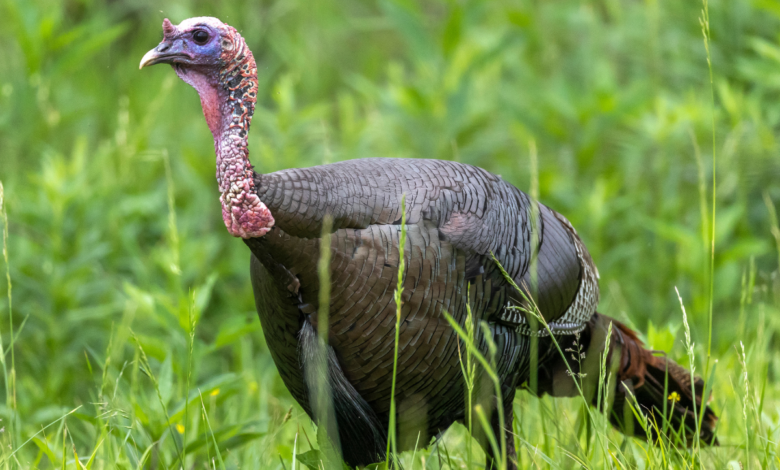A Complete Guide to Roosting a Turkey

You may have heard the advice a million times- the secret to a successful turkey hunt is proper preparation. Roosting a turkey is an important step in preparing and getting your hunting strategy right.
The term roosting is used for identifying the resting location of the bird on a limb. In other words, you find out the tree where the bird sleeps and increase your chances of killing the gobbler the next morning.
While that may sound pretty simple, you need to know the right techniques.
Wondering how to roost a turkey? Just keep reading.
What Time Do Turkeys Roost?
Turkeys do not head for the roost until the last minutes of daylight. The roosting time starts from 20-30 minutes before sunset and continues through the twilight period.
Since turkeys lack powerful night vision, you can expect them to sit up on the roost before darkness sets in at the ground level.
As daylight shortens, you can expect the roosting pattern to change. In fall and early winter, turkeys will roost earlier compared to summer.
What Time Do Turkeys Come Off the Roost?
Predicting the exact time when a bird will leave the roost is not easy, as it depends a lot on the weather. In general, the period is between 5:00 to 9:00 a.m.
In clear conditions, the chances are that a bird will leave the roost within 30 minutes of first light. But if it is foggy or rainy this may get delayed by 2-3 hours.
In extreme winters, you can expect them to hunker down for longer hours, using their feathers to keep their feet warm. I have seen turkeys staying in the tree for weeks to avoid the cold and losing chunks of their body mass due to the non-availability of food.
You can never know what other factors affect the behavioral patterns of the animals. If there are coyotes or other predators in the area, they will tend to stay up in the tree for longer periods. Secondary factors like the presence of hunters, noise, and other disturbances can have a similar effect.
Now, if you are the only hunter in an area, you can have more control over these secondary factors. If not, think of modifying your hunting plans based on the hunting pressure in the area.
How to Roost a Turkey
The idea of roosting a turkey is to have a better understanding of its movement patterns. By knowing the tree the gobbler has chosen as a bedroom, you can target it better when it flies down in the morning.
If you are hunting in a new area or a farm, aerial photos and topo maps are a great help. These will help you understand the terrain and identify the land features. That way, you will be able to nail down the probable roosting spots with better accuracy and save a lot of time.
Find Their Favorite Morning Spot
The roosting patterns of turkeys are somewhat unpredictable. I have seen a thick layer of turkey droppings under a particular tree limb- a result of the bird sleeping in the same spot for months. But in heavily populated areas, they may choose a different roosting site for every night.
If you have found their favorite morning spot, chances are, the roost will be nearby. Look out for, taller trees around 40 to 50 feet, with plenty of horizontal limbs. The ones with their lowest branches high off the ground are preferred options.
Since gobblers hate surprises, they do not pick areas that have ground cover like bushes and tall grass. Check for droppings or feathers under large cedars and maples.
The other option is to listen for gobbles or cackles during the evening hours. Now, you can never be sure that a bird is going to gobble. Once I was out turkey hunting in Michigan and found the birds to be exceptionally silent throughout the day. But then a thunderstorm hit and kept the toms awake all through the night. Every time the thunder hits, the bird gobbles.
However, one thing you can be sure of is the tom’s interest in locating hens. To find the exact location, get them to gobble with a locator call or two.
After you hear a few gobbles, it is time to zero in. If you are not sure of the exact location, move to a different angle and make him gobble again. Keep in mind, if the bird is gobbling facing away from you, it may sound further away than he is. The reverse can be true if he is gobbling while facing you.
Bring Binoculars
I admit that even with the modern lightweight versions, carrying binoculars can be cumbersome at times.
Still, I suggest not hitting the woods without them, whether you are roosting or scouting. Relying on your hearing and woodsmanship skills is not enough as turkeys are not always gobbling.
The reason is, that I do not want to spook the birds by going too close to them. Considering that an average wild turkey has incredible vision, binoculars are your best bet to beat their senses at the long-distance viewing game.
You can watch a group from afar, and with luck, might even spot where they roost.
And you do not need extra powerful binoculars for turkey hunts. An 8x magnification works great. If you want a closer look through the foliage, go for a 10x magnification. I’d also suggest picking one with an exit pupil of 4 mm or higher.
Don’t Get Too Close
It is best to spy on a group of birds and watch them move toward a roosting area, from a vantage point. But if you get too close, you might bust the bird from its roosting spots. Once a roost is disturbed, the birds may leave the area for good.
Speaking of distance, if you can see the flock, they can see you too. So, if your choice of turkey load demands a closer distance, stealth and patience are your best friends. Also, this is where a bino comes in handy.
It is not easy to answer the question of how close is too close. In thick woods, a distance of 200 yards should be a reasonable limit. In open fields, you can extend the range to over 500 yards.
Stay As Quiet As Possible
I do think that staying silent while slipping into position is another important aspect of Turkey roosting. Any unnatural sounds will alert the birds and make them move away from the location. Staying silent will also allow you to listen to the gobbling more clearly.
Also, resist the urge to use locator calls more often than necessary. During my early hunts, I scared a few birds into the next county by over-calling. Over time I have realized that occasional aggressive calling has its advantages, but not while roosting a turkey.
Hunt in the Evening
Once you have nailed the roost, the last few hours of daylight can present some of the best hunting opportunities you will find. Another advantage is, that the calling and hunting pressure will reduce after noon in most settings. But, do not forget to check if you are within the legal hunting hours of your state.
While the birds are headed to roost they will also stop to feed. So, sitting tight near a feeding area or a water source is a good idea.
Note that these ambush locations are specially for evenings and are to be avoided during the morning or midday.
Resist the temptation to move too close to the roosting spot. This will disturb the moving pattern of the birds and once alerted they might leave the area. And remember: since hens are less vocal during the late hours, use calls sparingly.
As it gets closer to dusk, you need to get more careful. When you know where to aim at a turkey, you will also know that making a hit can get difficult with the light dropping sharply. It is best to select a spot on a route that leads to the roost site. That way, even with a screw-up, the birds will not assume that their roost site is under threat.
Use Decoys
Honestly, I do not use decoys frequently. And one reason for that is my dislike for the extra bulk. If your average hunting days involve long walks, you know what I am talking about. But with plenty of hyper-realistic decoys on the market, they can be a good option when you are hunting within a smaller zone.
The idea of a hen decoy is to draw the gobblers from long distances. So, it is best to set them up in open fields. If the roost is in a heavily wooded area, using decoys offers less chance of success.
A warning though. Careless hunters may mistake a decoy for the real thing. So make sure to position yourself away from the line of fire. Setting them up at a distance of 20 yards from your hiding spot is a good idea.
Roosting a Turkey: FAQs
Do turkeys roost in the same place every night?
Turkeys may not use the same place for roosting every night and move to a different location. However, some turkeys use their traditional roost sites every night.
How far will a turkey travel from its roost?
Wild turkeys can travel a mile or two from the roost depending on weather conditions. The distances can vary if the weather is too cold or too dry.
What time do turkeys start gobbling on the roost?
Turkeys can gobble while roosting and may start gobbling 20-40 minutes before sunrise.
How do you find where turkeys are roosting?
The best way is to use your experience as a woodsman and read the signs of roosting. These are accumulated droppings and feathers. Besides, you need to stay alert and use your eyes and ears to spot the location.
Final Thoughts
If you think that a gobbling tom in the roost is as good as a roasted tom, think again. Unless you have a proper strategy for the next day, roosting a turkey does not guarantee a kill.
Once you have spotted a roost, make sure to leave as carefully as you have moved into the zone. Even if your hunting strategy does not work on a particular day, you will gain valuable experience from locating a roost.
And trust me, roosting a turkey is a big part of the fun package that turkey hunting offers.



